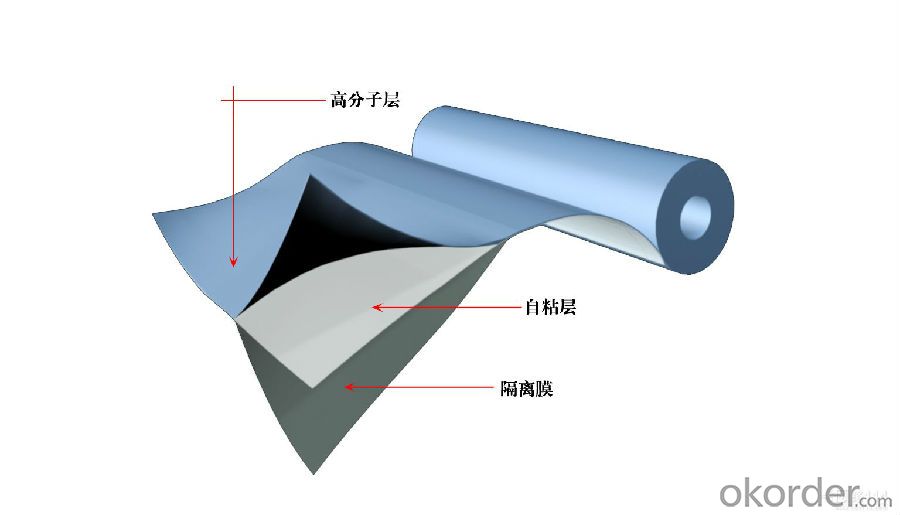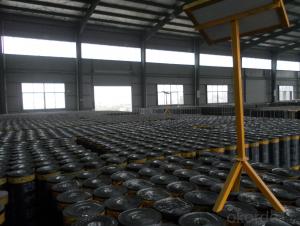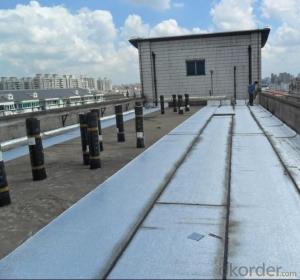Self Adhesive Bitumen Waterproof Membrane for Roofing
- Loading Port:
- China main port
- Payment Terms:
- TT OR LC
- Min Order Qty:
- 5000 m²
- Supply Capability:
- 100000 m²/month
OKorder Service Pledge
OKorder Financial Service
You Might Also Like
Introduction
Self adhesive waterproofing material ismade by saturating the base in bitumen, or thermoplastic elastomer (such as styrene butadiene), reinforced with polyester or fiberglass, finishing the upward face with fine sands, mineral slates (or grains) or polythene membrane etc. It has the outstanding performance such as: convenient to apply, no environmental pollution etc. This product is consisting of two kinds: without reinforcement and polyester reinforcement.
Specification
Thickness | 3mm, 4mm, 5mm |
Width | 1m |
length | 7.5m, 10m, 15m, or on demand |
Base | Polyester or Fiberglass felt |
Surface | PE film, Aluminum foil, Yellow sand, Shale gravel(Schist), colored sand |
Type | could self-adhesive |
Notice | SBS modified bitumen membrane is specially applied in the cold district, APP modified bitumen membrane is more suitable for hot district with high temperature. could be self-adhesive modified bitumen membrane |
Advantages
1) Cold-applied construction with no open flame and self-adhesion without bonding agent make it safe, low- carbon, environmental, and economical.
2) Excellent adhesive performance guarantees the integrity of waterproof layer.
3) Good rubber elasticity, elongation and shear stress.
4) Good low-temperature property.
FAQ
1. Is sample available before place orders?
A: Yes, sample is ok.
2. How long is the dispatch period?
A: It will be around 20-30 days.

- Q:Can a waterproofing membrane be used on concrete slabs or foundations?
- Concrete slabs or foundations can benefit from the application of a waterproofing membrane. These membranes are widely used in construction to safeguard structures against moisture damage and water infiltration. When a waterproofing membrane is applied to a concrete slab or foundation, it forms a protective barrier that prevents water from permeating the concrete and causing problems such as cracking, water damage, or mold growth. This specially designed membrane is capable of enduring hydrostatic pressure, which is the force exerted by still water, and it effectively ensures a dry environment. It is essential to choose a suitable waterproofing membrane that is compatible with the concrete and the specific project conditions. Adequate installation and maintenance of the membrane are also vital for long-lasting waterproofing effectiveness.
- Q:What is the typical installation process for a waterproofing membrane?
- Installing a waterproofing membrane typically involves several steps. Firstly, the surface requiring waterproofing is thoroughly cleaned and prepared by eliminating any existing coatings, debris, or loose materials. It is essential to guarantee that the surface is smooth, clean, and devoid of any contaminants that may hinder the membrane's adhesion. Secondly, any cracks, holes, or imperfections in the surface are repaired. This entails filling cracks with a suitable filler or patching compound and smoothing out rough areas. It is crucial to have a solid and even surface to ensure proper installation and efficacy of the waterproofing membrane. Once the surface is prepared, it is often necessary to apply a primer to enhance adhesion between the surface and the membrane. The primer is typically applied using a brush or roller, following the manufacturer's instructions. After the primer has dried, the waterproofing membrane is mounted. There are various types of membranes available, such as sheet membranes or liquid-applied membranes. Sheet membranes are usually rolled out onto the surface and adhered using an appropriate adhesive or mortar. Liquid-applied membranes are applied using a brush, roller, or spray equipment to create a continuous and seamless barrier. Throughout the installation process, it is crucial to ensure correct membrane installation with proper overlap or seams. Additionally, any penetrations or transitions must be adequately treated and sealed. This includes areas such as corners, edges, drains, and pipe penetrations, where additional detailing may be necessary to create a watertight seal. Once the membrane is installed, it is important to allow it to cure or dry according to the manufacturer's instructions. This ensures that the membrane reaches its maximum strength and waterproofing capabilities. Finally, after the membrane has cured, it may be beneficial to apply a protective layer or coating to enhance the durability and longevity of the waterproofing system. This may involve applying a topcoat, sealant, or protective barrier to shield the membrane from UV rays, foot traffic, or other potential sources of damage. In summary, the installation process for a waterproofing membrane includes surface preparation, primer application, membrane installation, detailing and sealing, curing, and potentially applying a protective layer. It is crucial to adhere to the manufacturer's instructions and consult with a professional if necessary to ensure proper and effective installation.
- Q:Can a waterproofing membrane be used for tunnels or subway systems?
- Tunnels and subway systems frequently encounter water infiltration as a result of the soil conditions or groundwater levels in their vicinity. To counteract this issue, a waterproofing membrane is commonly employed. This membrane serves as a protective shield, effectively obstructing water from permeating into the tunnels or subway systems. Its installation is typically carried out on the outer surfaces of the tunnel walls and roof, establishing an impervious seal. By doing so, it aids in the prevention of corrosion, decay, and harm to the structural components of the tunnels, guaranteeing the durability and safety of these subterranean infrastructures.
- Q:Does a waterproofing membrane require a protective layer?
- Yes, a waterproofing membrane typically requires a protective layer. The protective layer helps to shield the membrane from various external factors, such as UV rays, weather conditions, mechanical damage, and chemical exposure, thereby enhancing its durability and longevity.
- Q:Are waterproofing membranes effective in preventing water damage?
- Yes, waterproofing membranes are effective in preventing water damage. They provide a barrier that prevents water from penetrating into the structure, helping to keep it dry and protected against potential water-related issues such as leaks, mold growth, and deterioration.
- Q:Roof SBS waterproofing membrane can not empty shop
- Waterproof membrane: waterproofing membrane is mainly used for building walls, roofs, and tunnels, highways, landfills, etc., to resist the external rain, groundwater leakage can be curled into a roll of flexible building materials , As the engineering foundation and the building between the no leakage connection, is the entire project waterproof first barrier, the whole project plays a vital role. The main products are asphalt waterproofing membrane and polymer waterproofing membrane.
- Q:Does a waterproofing membrane provide any additional structural reinforcement?
- A waterproofing membrane does not offer any additional structural reinforcement; rather, its main function is to prevent water or moisture from entering a building or structure. This membrane acts as a barrier, typically applied on the outer surface, to keep water out and safeguard the underlying materials against water damage. While it can improve the durability and longevity of a structure by preventing water-related issues such as leaks, dampness, or mold growth, it does not contribute to the building's structural integrity or strength. Structural reinforcement is usually achieved through the use of materials like steel, concrete, or other load-bearing components, which are designed to support and distribute the weight and loads of the structure.
- Q:Can a waterproofing membrane be used on precast glass surfaces?
- Yes, a waterproofing membrane can be used on precast glass surfaces to provide an additional layer of protection against water infiltration and ensure the longevity of the structure.
- Q:Can a waterproofing membrane be used for concrete bridge decks?
- Yes, a waterproofing membrane can be used for concrete bridge decks. A waterproofing membrane is a thin layer of material that is applied to the surface of the bridge deck to prevent water infiltration and protect the concrete from deterioration caused by moisture. This membrane is designed to be flexible and durable, providing a barrier against water while allowing for the movement and expansion of the bridge deck. It is typically applied in multiple layers and can be either hot-applied or cold-applied, depending on the specific project requirements. The use of a waterproofing membrane on concrete bridge decks helps to extend the service life of the structure by preventing water damage, reducing the need for frequent repairs and maintenance, and improving overall structural integrity.
- Q:Can a waterproofing membrane be used on precast stone surfaces?
- Indeed, the utilization of a waterproofing membrane is viable on precast stone surfaces. Similar to all other concrete or masonry surfaces, precast stone surfaces are prone to water infiltration, which may lead to long-term damage. By applying a waterproofing membrane onto the precast stone surface, one can effectively prevent water penetration and shield the stone from moisture-related problems such as cracking, spalling, and efflorescence. This membrane establishes a barrier that hinders water seepage into the stone while still permitting it to respire and release any trapped moisture. Hence, it is crucial to select a waterproofing membrane that is compatible with the precast stone material and meticulously adhere to the manufacturer's instructions for proper application.
1. Manufacturer Overview |
|
|---|---|
| Location | |
| Year Established | |
| Annual Output Value | |
| Main Markets | |
| Company Certifications | |
2. Manufacturer Certificates |
|
|---|---|
| a) Certification Name | |
| Range | |
| Reference | |
| Validity Period | |
3. Manufacturer Capability |
|
|---|---|
| a)Trade Capacity | |
| Nearest Port | |
| Export Percentage | |
| No.of Employees in Trade Department | |
| Language Spoken: | |
| b)Factory Information | |
| Factory Size: | |
| No. of Production Lines | |
| Contract Manufacturing | |
| Product Price Range | |
Send your message to us
Self Adhesive Bitumen Waterproof Membrane for Roofing
- Loading Port:
- China main port
- Payment Terms:
- TT OR LC
- Min Order Qty:
- 5000 m²
- Supply Capability:
- 100000 m²/month
OKorder Service Pledge
OKorder Financial Service
Similar products
New products
Hot products
Hot Searches
Related keywords



























